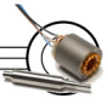British Inventions
that changed the world
Three british inventions in communication, energy and health that changed the world.
The world wide web (aka WWW, W3, Web) was invented by British computer scientist Timothy Berners-Lee.
Berners-Lee developed the Web in 1989 while working for the European Organization for Nuclear Research (CERN) in Geneva, Switzerland.
The Web is a system that uses the Internet to link to and access information (text, images, and multimedia) by using a web browser. These links are known as Hypertext Transfer Protocol (http).
The Web was invented to allow researchers to collaborate with each other and to share their information on projects.
 In 1990, Berners-Lee created the first web server (info.cern.ch), the first web page (info.cern.ch/hypertext/WWW/TheProject.html), and the first web browser (NeXT).
In 1990, Berners-Lee created the first web server (info.cern.ch), the first web page (info.cern.ch/hypertext/WWW/TheProject.html), and the first web browser (NeXT).
In 1994, Berners-Lee created a World Wide Web Consortium (W3C) at the Massachusetts Institute of Technology, to create standards for the Web and to ensure that his invention would be patent-free and royalty-free technology that anyone could use.
Berniers-Lee has received numerous honors for his work. He received a knighthood from the Queen of England and an election to the United States National Academy of Sciences.
Time Magazine identified Berners-Lee as among the 100 Most Important People of the 20th Century.
Penicillin
 Bacteria uses antibiotics to protect themselves against organisms that threaten their survival.
Bacteria uses antibiotics to protect themselves against organisms that threaten their survival.
Penicillin is the name attributed to the antibiotic created by the penicillium bacterium.
British bacteriologist Alexander Fleming noticed that a culture of Staphylococcus (a bacteria that can cause severe infections in humans) was being dissolved by a contamination of blue-green mold.
Fleming discovered that the mold produced an antibiotic that killed numerous bacteria harmful to humans, which he named penicillin.
However, it wasn't until the 1940s that penicillin's chemical composition was isolated and developed into a therapeutic medicine by British biochemist Ernst Boris Chain, and Australian pharmacologist and pathologist, Howard Florey.
In 1945, Fleming, Florey and Chain were jointly awarded the Nobel Prize in Medicine.
Electric Motor
 Michael Faraday, a self-taught physicist and creator of many British inventions, invented the electric motor from his discovery of electromagnetic induction.
Michael Faraday, a self-taught physicist and creator of many British inventions, invented the electric motor from his discovery of electromagnetic induction.
Faraday studied the published works of various physicists (Danish physicist, Hans Ørsted; French physicist, André-Marie Ampère; German physicist, Johann Schweigger) and their experiments on how electric current created magnetic fields.
Faraday concluded that electric current and magnetic fields were not separate phenomena but rather just different perceptions of the same thing.
In 1831, he invented an electromagnetic induction ring, which was a rotating disc between poles in a horseshoe magnet attached to wires.
When the disc rotated it created a magnetic effect that produced a flow of electrical current through the wires. This British invention became known as the electric motor.
Photo credit: Miqueias







